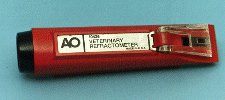Total Protein by Refractometry
 The
protein value reported on the routine CBC is only
an estimate, based on the refractive index
of the plasma. Three important points need to be made
regarding this procedure. The
protein value reported on the routine CBC is only
an estimate, based on the refractive index
of the plasma. Three important points need to be made
regarding this procedure.
- Since it is determined using EDTA plasma (which contains
fibrinogen), this value usually will be 200-500 mg/dL higher than
the total protein on a chemistry panel (which is performed on serum).
- The use of refractometry is valid for providing an estimate
of plasma protein concentration, since protein is the major determinant
of refractive index of plasma. It is not, however, the only contributor.
All other dissolved solids (glucose, BUN, cholesterol, etc) also make
a contribution. In using a refractometer to "measure" protein, one
is assuming that all non-protein solids are identical from one sample
to the next. This is a big assumption and is not always correct. The
estimate of protein based on refractometry will be significantly biased
in patients with marked deviations from normal concentration of non-protein
solids in blood.
- For valid results, the plasma sample must be optically clear. Lipemic
(blood or chylous pleural fluid) or hemolyzed fluids, for example,
will yield erroneously high results.
Last Updated: June 2000
|